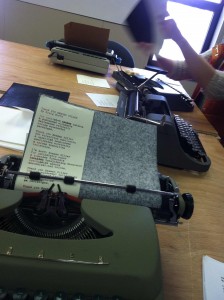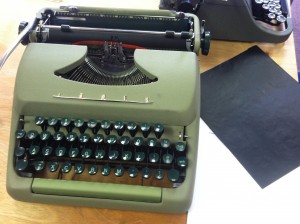When Jim came home from a meeting at Boundedition, our local print-oriented Maker space, with news of a Harlequin Creature Typing Bee happening the next day in Ann Arbor, I signed up online right away. Actually, I volunteered to help after he assured me that the call was for helpers, not just excellent typists.
What is Harlequin Creature? It is a journal of poetry and prose that is hand-typed at typing bees by a circle of friends and volunteers from Los Angeles to Ann Arbor to New York. Copies are hand-bound and numbered; a limited number include artwork by a feature artist. The journals are available at 9 bookstores and shops across the globe, as well as by pre-order online for the next issue. As an organization, Harlequin Creature is a 501(c)3 not-for-profit corporation founded in 2012 in New York.
I showed up at Boundedition on Sunday morning, ready to type and learn. From a table of vintage manual typewriters and one electric one, I choose a noble vintage Sears Roebuck Tower on which to type my copies. Here are my 5 take-away lessons:
1. Many hands make light work.
More accurately, many hands make work fun. Sitting around a table with a group of people working on a common project is a lovely way to feel motivated and connected. Like a barn raising or a quilting bee, the results of our typing labors were right in front of us: a small stack of finished typed pages.
2. Clear expectations help people relax.
I was worried about whether my typing abilities would be up to snuff, but Harlequin Creature creator and editor as well as the host of today’s event, Meghan Forbes was very clear that perfection was not the expectation or the goal. In fact, she said she encourages mistakes, which made me smile. In typing the pages of the journal, each typist becomes in effect its author, leaving his or her marks on the pages. White Out? No way! XXXing out is the way to go!
3. Mistakes add character.
Like a quilt with a built-in flaw (which may be a myth, I recently learned), our copies were individualized by the choices and errors of the typists. I worried that maybe my copy would be unusable, but again Meghan assured me that my typing was “good enough.” I wish my 8th grade typing teacher had ever once said that!
4. Typing is hard work.
My hands were tired by the time I finished typing the poems for my copies (#7 and #8 of Volume 5, by the way). Using a typewriter is a very physical process. It took some time for my fingers to remember the rhythm, and to be frank, they didn’t do a great job. In addition to accuracy, I had to think about strength and timing. The keys are mechanical, on a manual typewriter that is; hitting too softly results in faint characters appearing on the page. Hit too hard, and the middle of the “o” might pop or at least the character will appear darker than its neighbors. In terms of speed, I had to try hard to hit that gold pace of pretty steady, but not too fast. Trying to speed along can result in a key-pile-up with a mashed up mess on the page. In addition to the action from the keys, I had to remember how to deal with the action of the typewriter. As I worked, it scooched across the table, so I had to recenter it every couple of returns.
5. It’s nice to be appreciated.
Meghan was a welcoming host who made the experience very fun. She was also a gracious and grateful leader, which is something every volunteer likes to see. She answered all of my questions about the journal and the creative process. We enjoyed bagels and conversation as well as the gift of a little handmade journal, along with her thanks.
I’m so glad I had the chance to experience a Harlequin Creature typing bee, and I look forward to doing it again!




